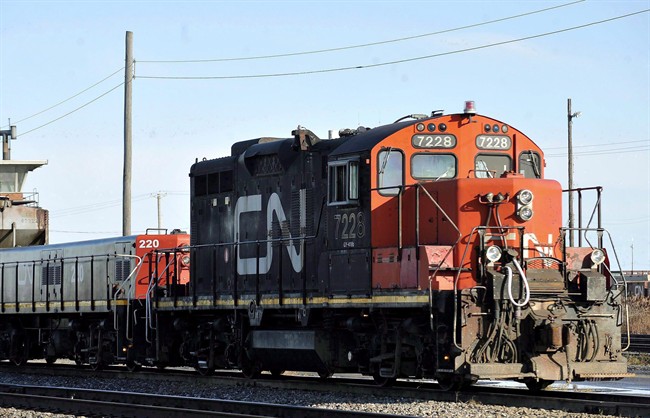The Transportation Safety Board (TSB) says a train was travelling at a speed of 43 km/h through a curve and didn’t obey a restricted speed signal before hitting another train on June 4, 2016.

CN train 112 was heading east from Edson to Edmonton, Alta. when it collided with the tail end of train 302, which was stopped near Carvel, which is about 35 kilometres west of Edmonton.
In a report released Tuesday, the TSB found that “proceeding past a restricted speed signal led to two trains colliding.”
(Scroll down to read the full TSB report)
The TSB points out a number of safety risks, including the lack of “fail-safe defences” to ensure signals are always seen and followed.
When the two trains collided, no cars derailed, the board said. The crew on train 302 didn’t feel any impact and workers on train 112 didn’t notice any immediate damage to the tail end of train 302.
“The crew… did not see that one empty hopper car had sustained minor damage and did not report the incident,” the report stated.
A recorder and forward-facing video camera on the train later confirmed the collision.
“The investigation found that, after correctly identifying a signal calling for reduced speed, the crew of train 112 passed the signal at a speed that exceeded the limit. As such, they were unable to stop in time to avoid the collision with train 302,” the TSB said.
- Life in the forest: How Stanley Park’s longest resident survived a changing landscape
- ‘Love at first sight’: Snow leopard at Toronto Zoo pregnant for 1st time
- Carbon rebate labelling in bank deposits fuelling confusion, minister says
- Buzz kill? Gen Z less interested in coffee than older Canadians, survey shows
The report found the emergency brake was applied and the train was travelling at about 29 km/h when it made impact.
Not following railway signal indications is on TSB’s 2016 Watchlist, a list of 10 key safety issues that need to be addressed.
Since 1998, the TSB has investigated 13 other similar incidents and issues two recommendations, calling for implementation of physical train controls and additional backup safety defences to make sure signals are followed.
READ MORE: TSB warns of safety flaw at site of fatal accident involving a train and ambulance in Langley
The report points out the crew of train 112 also failed to properly report the June 2016 incident.
“If relevant safety data, including incident or rule violation reports, are not available to help identify safety issues, emerging trends involving unsafe events may not be identified in a timely manner, increasing the risk of accidents,” TSB said.
“In this occurrence, the decision not to report the collision resulted in only a cursory inspection of both trains, rather than the required thorough inspections.”
Transportation Safety Board of Canada- Railway investigation report by Anonymous TdomnV9OD4 on Scribd




Comments